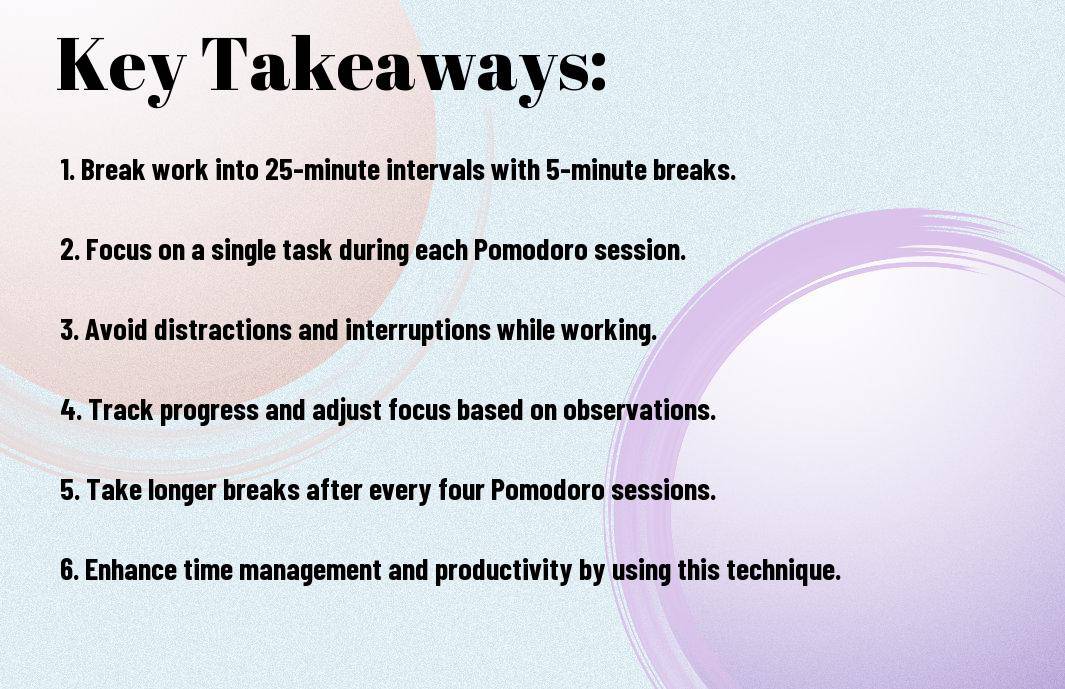
Newsletter Subscribe
Enter your email address below and subscribe to our newsletter

Enter your email address below and subscribe to our newsletter

Pomodoro Technique! It’s no secret that in today’s fast-paced world, maintaining focus and managing time efficiently can be a challenging task. However, there is a method that has been proven to be effective in helping individuals enhance their productivity levels – the Pomodoro Technique, developed by Francesco Cirillo. This time management method is designed to break work into intervals, typically 25 minutes each, separated by short breaks, to improve concentration and overall output.


The
Any individual looking to enhance productivity and time management can benefit from understanding the core principles of the Pomodoro Technique. At its essence, this method revolves around breaking work into focused intervals, typically 25 minutes long, known as Pomodoros. During these Pomodoros, one should concentrate solely on the task at hand, eliminating distractions and interruptions.
Key to the technique is the concept of taking short, scheduled breaks between each Pomodoro to refresh the mind and prevent burnout. By adhering to this structured approach, individuals can enhance their focus, maintain motivation, and ultimately accomplish more in less time.
Pomodoro cycles consist of four main components: a Pomodoro (work interval), a short break, a longer break, and repeated cycles. The Pomodoro Technique encourages individuals to work with time, rather than against it, by harnessing the power of focused work sessions and strategic breaks.
The structured nature of the Pomodoro Technique not only aids in optimizing productivity but also helps individuals maintain a healthy work-life balance by preventing overexertion and mental fatigue. Understanding the breakdown of the Pomodoro cycle is key to mastering this effective time management method.
Despite the simplicity of the Pomodoro Technique, setting yourself up for success is crucial to fully benefit from this time management method. By ensuring you have the necessary tools and creating the right environment, you can optimize your focus and productivity.
An necessary tool for implementing the Pomodoro Technique is a timer or a Pomodoro app that can track your work and break intervals accurately. This helps you stay disciplined and stick to the designated time blocks. Additionally, a to-do list or task manager can assist in prioritizing your tasks and determining what to focus on during each Pomodoro session.
Any individual can customize the Pomodoro Technique to suit their unique working style and preferences. Some may find that shorter or longer Pomodoro sessions work better for them, while others may prefer adjusting the length of breaks between sessions. It’s important to experiment with different variations to find what works best for you.
Another way to tailor the technique is to incorporate specific strategies for managing distractions based on your habits and environment. For example, if you are easily tempted by social media notifications, you can turn off alerts during Pomodoro sessions to maintain focus. By adapting the technique to your individual needs, you can enhance your efficiency and achieve better results.
Your journey with the Pomodoro Technique begins by identifying the tasks you need to accomplish. It is vital to technique break down your work into manageable segments that can be completed within a 25-minute time frame, known as a Pomodoro. Make a list of tasks you want to tackle and prioritize them based on importance and deadline. This will help you stay focused and organized throughout the day.
The first step in implementing the Pomodoro Technique is to set a timer for 25 minutes and focus solely on the task at hand. Eliminate all distractions and work diligently until the timer goes off. Once the Pomodoro is complete, take a short 5-minute break to rest and recharge before starting the next Pomodoro. This cycle of focused work and short breaks will help you maintain high productivity levels and avoid burnout.
First Pomodoro sets the tone for your work session and establishes a rhythm for the rest of the day. It is crucial to commit fully to the task during this time and resist the temptation to multitask. By dedicating your full attention to the task at hand, you can achieve more in less time and improve your overall focus and time management skills.
Once again, managing distractions and interruptions is crucial when trying to improve focus and manage time effectively using the Pomodoro Technique. Distractions can come from both internal and external sources, hindering productivity and causing delays in completing tasks.
Managing internal distractions involves self-awareness and self-discipline. One effective strategy is to identify your most common internal distractions, such as negative thoughts, worries, or impulses to check social media. Once identified, develop a plan to address each distraction as it arises. This could include practicing mindfulness techniques, setting specific time blocks for addressing personal concerns, or using visualization exercises to stay focused on the task at hand.
One of the key aspects of dealing with external distractions is setting boundaries. Inform your colleagues, friends, or family about your dedicated focus time and request not to be interrupted during those periods. If you work in a noisy environment, consider using noise-canceling headphones or finding a quiet space where you can concentrate without disruptions. Additionally, utilize tools such as website blockers or apps that limit notifications to minimize external interruptions.
Distractions can significantly impact your productivity and time management efforts. By implementing strategies to handle both internal and external distractions, you can create a more focused work environment and improve your ability to manage time effectively using the Pomodoro Technique.

Keep your Pomodoro sessions productive and efficient with these advanced tactics:
| Pomodoro Technique | Time Blocking |
| Focuses on single tasks in short intervals | Allocates specific blocks of time for different tasks |
Pomodoro Technique can be integrated with other time management systems like Time Blocking. By combining the two, you can benefit from both the focused bursts of work that Pomodoro offers and the structured approach to managing your day that Time Blocking provides. This hybrid method allows you to allocate specific time slots for Pomodoro sessions within your daily schedule, ensuring you stay focused on your tasks while also managing your time effectively.
Pomodoro Technique can be adapted for team and collaborative work environments by implementing group Pomodoro sessions. Team members can synchronize their Pomodoro timers to work on shared tasks simultaneously. This approach promotes accountability, enhances communication, and fosters teamwork among team members. Additionally, incorporating brief breaks between Pomodoro sessions allows for quick team check-ins and discussions, enabling a seamless flow of collaboration.
Team collaboration is vital for the success of any project. By adapting the Pomodoro Technique for team use, you can leverage the benefits of increased accountability, improved communication, and enhanced teamwork dynamics. Encouraging team members to align their focus and work together in synchronized Pomodoro sessions can lead to heightened productivity and more efficient task completion.
Now that you have familiarized yourself with the Pomodoro Technique, it is necessary to track your progress and make necessary adjustments to maximize its benefits. By measuring and recording your Pomodoro sessions, you can gain valuable insights into your productivity patterns and identify areas for improvement.
For each Pomodoro session, keep a log of the tasks you worked on, the duration of each Pomodoro, and any interruptions or distractions you encountered. You can use a simple notebook, a digital spreadsheet, or specialized apps designed for Pomodoro tracking. By monitoring your sessions, you can identify trends in your focus levels, evaluate the effectiveness of your task estimates, and adjust your workflow accordingly.
Pomodoro Technique allows for flexibility in its application. If you find yourself consistently struggling to maintain focus for the full 25 minutes, consider shortening your Pomodoro sessions to 15 or 10 minutes. On the other hand, if you are frequently in a state of flow and find the 25-minute intervals too short, experiment with longer Pomodoros of 30 or 45 minutes. Adapting the technique to suit your natural work rhythms can significantly enhance your productivity and concentration levels.
Progress: Remember that the Pomodoro Technique is a tool to help you work smarter, not harder. While it can be tempting to push yourself to complete more Pomodoros in a day, be mindful of the quality of your work and the impact on your overall well-being. Take breaks when needed, stay hydrated, and listen to your body’s signals to ensure long-term success with the technique.

For many people, integrating the Pomodoro Technique into their daily routine can present some challenges. The most common challenge is the temptation to multitask. It can be difficult to resist the urge to check emails, scroll through social media, or engage in other distracting activities during the focused work periods. This can significantly reduce the effectiveness of the technique and hinder productivity.
Another challenge is adapting to the strict time constraints of the Pomodoro Technique. Some individuals may find it challenging to work in short, focused intervals and struggle to maintain their concentration for the entire 25-minute Pomodoro. This can lead to feelings of frustration and the perception that the technique is ineffective.
Technique misconceptions about the Pomodoro Technique can also hinder its successful implementation. One common misperception is that taking breaks frequently will disrupt workflow and decrease productivity. In reality, the frequent breaks are designed to recharge the brain and prevent burnout, ultimately enhancing focus and productivity in the long run.
To address this and other misconceptions, it is vital to educate individuals on the science behind the technique. Understanding how the Pomodoro Technique leverages the brain’s natural rhythm and capacity for focus can help individuals see the value in this time management method. By providing clarity and emphasizing the benefits of the technique, individuals can overcome misconceptions and fully embrace its effectiveness.
Taking this into account, the Pomodoro Technique by Francesco Cirillo is a proven method to boost focus and productivity. By breaking work into intervals and incorporating regular breaks, individuals can manage their time effectively and maintain high levels of concentration on tasks. This technique has been widely adopted and praised for its simplicity and effectiveness in improving work habits. To learn more about the Pomodoro Technique, visit Pomodoro Technique on Wikipedia.
A: The Pomodoro Technique is a time management method developed by Francesco Cirillo in the late 1980s. It involves breaking work into intervals, typically 25 minutes in length, separated by short breaks.
A: By working in focused bursts of time followed by short breaks, the Pomodoro Technique helps individuals maintain a high level of concentration on tasks, thereby improving focus and productivity.
A: The Pomodoro Technique involves the following steps: Choose a task, set a timer for 25 minutes, work on the task until the timer rings, take a short break (5 minutes), and after four cycles, take a longer break (15-30 minutes).
A: Yes, the Pomodoro Technique can be used by anyone looking to improve their time management skills and enhance focus. It is particularly beneficial for students, professionals, and anyone struggling with procrastination.
A: The Pomodoro Technique helps manage time by breaking tasks into shorter, more manageable intervals. This approach allows individuals to prioritize tasks, work efficiently, and avoid burnout by incorporating regular breaks.
A: Yes, there are variations of the Pomodoro Technique, such as adjusting the length of work intervals and break times based on individual preferences and needs. Some people also incorporate longer or shorter breaks between work cycles.
A: The benefits of using the Pomodoro Technique include improved focus, increased productivity, better time management, reduced procrastination, and decreased mental fatigue. It also helps individuals develop a sense of accomplishment as they complete tasks efficiently.
Night Before Planning – Preparing for Next-Day Productivity the Night Before
SMART Goals – George T. Doran’s Method for Setting Clear and Achievable Goals
The 2-Minute Rule – David Allen’s (popularized) Trick to Overcome Procrastination and Start Tasks
The Freelancer’s Guide to Optimizing Your Second Brain for Success